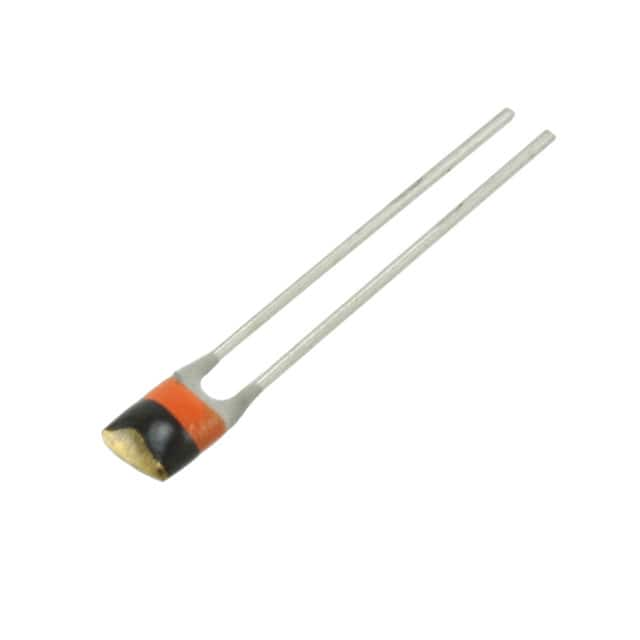NTCLE100E3339JB0
Product Overview
The NTCLE100E3339JB0 belongs to the category of NTC thermistors and is commonly used for temperature sensing and compensation in various electronic devices. This thermistor exhibits characteristics such as high sensitivity, small size, and a wide operating temperature range. It is typically available in a small package and is essential for precise temperature measurement and control in electronic circuits.
Basic Information
- Category: NTC Thermistors
- Use: Temperature sensing and compensation
- Characteristics: High sensitivity, small size, wide operating temperature range
- Package: Small form factor
- Essence: Precise temperature measurement and control
- Packaging/Quantity: Typically packaged in reels or trays, quantity varies based on supplier
Specifications
- Resistance at 25°C: 33.9 kΩ
- Tolerance: ±5%
- Operating Temperature Range: -55°C to 150°C
- Maximum Power Rating: 125 mW
- Thermal Time Constant: 7 seconds
Detailed Pin Configuration
The NTCLE100E3339JB0 typically has two leads with a specific pin configuration: 1. Pin 1: Connected to one end of the thermistor 2. Pin 2: Connected to the other end of the thermistor
Functional Features
- High sensitivity to temperature changes
- Small size for integration into compact designs
- Wide operating temperature range for versatile applications
- Reliable and accurate temperature measurement
Advantages and Disadvantages
Advantages
- High sensitivity enables precise temperature measurement
- Small size allows for integration into space-constrained designs
- Wide operating temperature range enhances versatility
Disadvantages
- Tolerance of ±5% may require calibration in some applications
- Limited maximum power rating may restrict use in high-power environments
Working Principles
The NTCLE100E3339JB0 operates based on the principle of negative temperature coefficient (NTC), where its resistance decreases as the temperature increases. This characteristic makes it suitable for temperature sensing and compensation in electronic circuits.
Detailed Application Field Plans
The NTCLE100E3339JB0 finds extensive application in various fields, including: - Consumer electronics for temperature monitoring and control - Automotive systems for climate control and battery management - Industrial equipment for thermal management and protection - Medical devices for temperature-sensitive applications
Detailed and Complete Alternative Models
Several alternative models to the NTCLE100E3339JB0 include: - NTCLE100E3103JB0 - NTCLE100E3473JB0 - NTCLE100E3223JB0 - NTCLE100E3683JB0
These alternatives offer similar temperature sensing and compensation capabilities with variations in resistance values and tolerances.
In conclusion, the NTCLE100E3339JB0 NTC thermistor serves as a crucial component for precise temperature measurement and control in diverse electronic applications, offering high sensitivity and a wide operating temperature range.
Word Count: 443
Senaraikan 10 soalan dan jawapan biasa yang berkaitan dengan aplikasi NTCLE100E3339JB0 dalam penyelesaian teknikal
What is the NTCLE100E3339JB0?
- The NTCLE100E3339JB0 is a thermistor, specifically an NTC (Negative Temperature Coefficient) thermistor, with a resistance of 33k ohms at 25°C.
How is the NTCLE100E3339JB0 used in temperature sensing applications?
- The NTCLE100E3339JB0 can be used as a temperature sensor in various technical solutions due to its change in resistance with temperature, making it suitable for temperature measurement and control.
What are the typical applications of the NTCLE100E3339JB0?
- The NTCLE100E3339JB0 is commonly used in temperature compensation, temperature measurement, and temperature control circuits in electronic devices and systems.
How does the NTCLE100E3339JB0 perform in temperature compensation?
- The NTCLE100E3339JB0 can be used to compensate for temperature variations in electronic circuits, ensuring stable performance across different temperature ranges.
Can the NTCLE100E3339JB0 be used in battery charging applications?
- Yes, the NTCLE100E3339JB0 can be utilized in battery charging applications to monitor and control the charging temperature, preventing overheating and optimizing charging efficiency.
What is the temperature range for which the NTCLE100E3339JB0 is suitable?
- The NTCLE100E3339JB0 is typically suitable for a wide temperature range, often from -40°C to 125°C, making it versatile for various environmental conditions.
How does the NTCLE100E3339JB0 interface with microcontrollers or other electronic components?
- The NTCLE100E3339JB0 can be interfaced with microcontrollers or other electronic components through simple voltage divider circuits or dedicated analog front-end circuits.
Are there any precautions to consider when using the NTCLE100E3339JB0 in technical solutions?
- It's important to protect the NTCLE100E3339JB0 from excessive current or voltage, ensure proper thermal coupling for accurate temperature sensing, and consider self-heating effects in high-accuracy applications.
Can the NTCLE100E3339JB0 be used in automotive applications?
- Yes, the NTCLE100E3339JB0 is suitable for automotive applications such as temperature monitoring in engine management systems, climate control, and battery management.
Where can I find detailed specifications and application notes for the NTCLE100E3339JB0?
- Detailed specifications and application notes for the NTCLE100E3339JB0 can be found in the datasheet provided by the manufacturer, as well as in technical literature and online resources related to thermistors and temperature sensing applications.


